|
FAQs on the Hydrozoan Identification
6
Related Articles: Hydrozoans, Cnidarians, Fire Corals, Stylasterines, Hydrozoan Jellies,
Related FAQs: Hydrozoan ID 1, Hydrozoan ID 2, Hydrozoan ID 3, Hydrozoan ID 4, Hydrozoan ID 5, Hydrozoan ID 7, Hydrozoan ID 8,& Hydrozoans 1, Hydrozoans 2, Hydrozoan Behavior, Hydrozoan Compatibility, Hydrozoan Selection, Hydrozoan Systems, Hydrozoan Feeding, Hydrozoan Disease, Hydrozoan Reproduction,
Medusoids/Jellies (Ctenophores, some Hydrozoans,
Scyphozoans): Jelly Identification, Jelly Behavior, Jelly Compatibility, Jelly Selection, Jelly Systems, Jelly Feeding, Jelly Disease, Jelly Reproduction, Fire Corals,
Lace
Corals, Stinging-celled
Animals
|
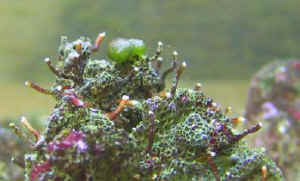
|
Distinguish Between Hydroids And Bispira Cluster
Dusters 9/12/09
Hello,
<Hi Vivian>
First of all I would like to thank you for this wonderful resource. I
have and continue to learn SO MUCH in this great (but addictive
hobby).
<You are welcome my dear, glad you enjoy.>
In any case, I have been searching through all your pages, but I cannot
resolve this issue. I have little beasts in my LR which, according to
pictures from some web sites are described as beneficial Bispira fun
worms . On the other hand, in some of your pages you do show pictures
of hydroids that look awfully similar to photo 1 (see photo).
<What photo?>
Do you have any pointers on how to distinguish between hydroids and
Bispira?
<Hydroids are any of numerous, usually colonial marine coelenterates
having a polyp rather than a Medusoid form as the dominant stage of the
life cycle. Hydroids have a simple cylindrical body with a mouth like
opening surrounded by tentacles. Most species form colonies with
individual hydroids branching off from a common hollow tube that is
probably used for sharing ingested food.
Bispira are basically a tubeworm and/or feather duster where the
"duster" is the crown of a worm that lives in a tube, and it
is both a feeding apparatus and a breathing gill.
Hydroids do not have or retract into a tube. I nice pic of a smaller
colony of Bispira for comparison can be seen here.
http://commons.wikimedia.org/wiki/File:Bispira_sp._(Tubeworm).jpg>
Thank you SO MUCH
<You're welcome. James (Salty Dog)>
best,
Vivian
Re Distinguish Between Hydroids And Bispira
Cluster Dusters 9/13/09
Thank you SO much James.
<You're welcome.>
That is a beautiful picture! From the practical point of view, given
that my Bispira or hydroids are so very tiny (I have to get a magnifier
glass) that I can not really go through the description with the
necessary detail, Do you think that then, an easy way to tell would be
to touch the prospective crow/ tentacles to see if they retract?
<Do try, if they are dusters, the crown will retract instantly,
revealing the tube..>
As an aside, I HAVE seen these tiny jellyfish kind of thingies beating
around the tank ( I do not have a camera good enough to show, but they
look like brown transparent umbrella shaped creatures of about
5mm.....I guess that would be consistent with hydroid medusas
(no?).
<Can be, dusters/fanworms do not roam.>
all the best,
<And to you. James (Salty Dog)>
Vivian
|
Worm ID and pics. 7/27/09
Hello crew!
<Duane>
I've been keeping fish (fresh and salt) for about a year and
a half now. I discovered your site fairly quickly after getting
into the hobby, and it has been an invaluable resource--thanks
for all you do. I also have Bob's CMA book, Bob and
Anthony's Reef Invertebrates book, Borneman's Aquarium
Corals. I have several other texts, but these are my key
references.
Between these and the FAQ's on WWM I've never had a need
to send an email to the crew before.
<Welcome to the camp!>
I'm wondering about the identification of a type of worm
<Mmmm>
I have in my chain of little reef tanks. I'll spare you (many
of) the tedious details except to say that the system is
comprised of a 20 gallon long that is partitioned into a small
settling chamber/skimmer pump compartment, overflowing into a
slightly larger refugium with DSB and Chaetomorpha that goes to
the surface, overflowing into a ~13 gallon display portion with
LR, multiple filter feeding organisms, soft and LPS corals, a
purple Firefish, and one fat, happy spotted mandarin. This
overflows into a 12 gallon Nano Cube with more rock, soft corals,
gorgonians, Corallimorphs, a Wheeler's shrimp goby with tiger
pistol shrimp, and a Banggai Cardinalfish. A powerhead in the
sump of the cube sends water back to the skimmer compartment to
flow back down again. The skimmer is rated for a 75 gallon system
and runs about 17 hours a day. I feed fairly heavily including a
wide variety of frozen and dry foods, live BBS, and Phyto-feast
Live. The system has been established for about 16 months now and
has a very healthy and diverse microfauna population including
spaghetti worms, (friendly) bristleworms, pods galore, etc.. Even
the portion with the mandarin has pods crawling all over the
glass at all hours.
There is one worm in particular that has had a strong presence in
the tank for some time now that I find very interesting and have
not seen in any of my books. I've been through all of the
Worm ID FAQ's here now and have found a couple possible
matching descriptions and blurry photos, but not enough for
anyone to make an ID. I recently managed to get a couple decent
photos of one and they are attached.
<See them>
This worm is white with small appendages all over it's body;
it has an appearance kind of like a feather boa. Single specimens
are maybe .5 cm in length when fully retracted, but can stretch
out to maybe 10 times that length. They tend to attach at one end
to rock or to macro algae--I first noticed these among the
strands of Chaeto in the 'fuge. They stretch out into the
water at the mercy of the currents, apparently feeding on
suspended organics, and contract every now and then in quick,
jerky motions. Then they slowly stretch back out to feed some
more . The photos show the worm extending from some c Caulerpa on
my blue tuxedo urchin. It's at about center frame, extending
to the right of the urchin. It's shown at near full length in
one shot, and not quite as near its shortest length in the other.
I'm not worried about these guys' presence, I'm sure
they're good for water quality and all that , but I am hoping
these pictures are good enough to give an ID more specific than
"some kind of worm". I was thinking maybe they're
nemerteans of some sort, but I'm not even sure of that. Any
ideas?
Thanks again for the great site,
Duane Harvey (near Detroit)
<I am strongly leaning to the side of this being a
Hydrozoan... Please see here:
http://wetwebmedia.com/hyzoanidfaq.htm
and the linked files above... I would try to "tweezer"
it out. Bob Fenner>
|
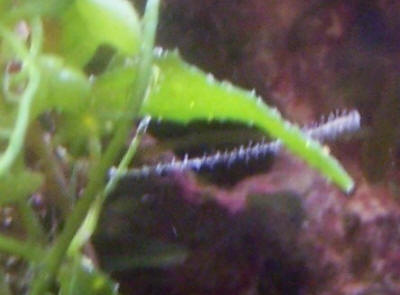 |
|
Re: Worm ID and pics.
7/27/2009
Bob,
>DH<
Thank you for the quick reply (original exchange copied below) .
I never would have guessed these to be hydrozoans, I'm glad I
asked! I have had transient populations of Hydrozoan jellies in
the past, and there is a small spot on one of my rocks that
intermittently sprouts a half-dozen or so tube-dwelling hydroids,
but they have never spread beyond that spot or been a problem so
I've left them alone.
<I think this is wise>
The white guys I sent the photos of are solitary, not colonial,
and their appendages are randomly placed rather than pinnate or
bilateral; those two things threw me, I guess.
<Perhaps I as well>
I said they have a "strong presence" in my system, but
that was overstating things a bit. A small but persistent
presence is more like it.
I've never seen them close enough to any of my corals to
touch them, and individuals seem to come and go fairly quickly.
It may be that the Lysmata wurdemanni I keep in the display areas
to control Aiptasia are also munching on the hydroids. In any
case, I'm not really inclined to go plucking them out just
yet, but I'll keep an eye on their numbers for sure--I have
been warned. These have been one of my favorite micro-critters in
the system since I first spotted them for their otherworldly
appearance and behavior.
My nitrates have been unmeasurable (API test kit) for some ten
months now, a plague of hydroids seem unlikely to me if I stay on
top of things. Of course, I could be wrong...........
Thanks again, and I was happy to see one of the photos made it
into the FAQ.
Take care,
dh
<You as well Duane. BobF>
Re: Worm ID and pics. -- 07/28/09
Hello again Mr Herr Sen or Fenner!
<Heeee! Just Bob will do Big D>
I think I have identified the genus of the mystery hydroid--this
is getting REALLY fun! It appears to belong to the genus
Candelabrum, formerly known as Myriothela. See Julian
Sprung's article at:
http://www.advancedaquarist.com/issues/june2003/invert.htm
<Ah yes>
Dr. Ron Shimek covers the genus in his Marine Invertebrates book
on page 33, but the photo shows a fully contracted specimen,
which is not the state in which one normally spots these things
in the tank. After a closer look at those in my tank when fully
contracted, the photo is actually pretty darn close. I find his
descriptor of "finger-like" projections when extended
to be somewhat misleading as well; I think the phrase
"worm-like" is a bit more like it. My annoying
nitpicking aside , some digging around shows that there is not a
whole lot of knowledge on this (mostly temperate) genus, though
descriptions of Myriothela in the literature can be found well
back into the 19th Century. Some hobbyists have reported plague
populations with corals suffering and the hands (or nematocysts)
of these animals, while others report only small populations that
come and go without incident. Most seem find them as interesting
to watch as I do.
<Outstanding!>
If you have any use for it, I can try to remove one from my tank
intact and get some pictures of it under a microscope we have
here at work.
<Mmm, no thank you>
Thanks, Danke, Gracias,
dh
<D'oh tashi mashiite my friend. BobF>
|
|
What is it question 01/22/09 I have posted
this on a couple of forums and have gotten various responses. My
tank is about 6 months old. I have added rock, sand and frags
from several different tanks and locations. They showed up one
time and thinking they were aiptasia I used pickling lime on
them. <Not aiptasia> They have shown up again and in two
different locations so I thought I should ask what they are.
<I believe they are hydroids.> They are pretty small, about
1/16 in diameter to give you a scale. Two pics: one is under 20k
MH with 460n actinic (darker one) the other is with same lighting
with flash bounced in from the top. What is it? <I'm 95%
sure they are some type of hydroid (the brown proteinaceous tubes
give them away).> Thanks, Steven
<De nada,
Sara M.>
|
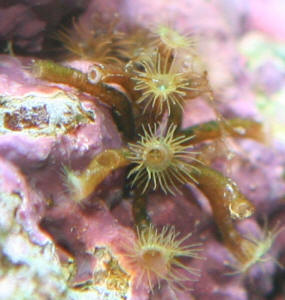 Well done. RMF Well done. RMF |
| <I agree with Sara, these are likely colonial Hydroids,
probably family Tubulariidae, possibly even of genus Tubularia or
related. Should not touch sensitive corals, may become a pest or
simply vanish someday within a short time. Nice pictures with great
detail. Thanks for sending. Marco.> |
|
Hydroids? Maybe Not -- Possible Spirorbids?
1/21/09 <Hello there> I have these strange white
spots that started on one side of my 125g reef tank and have
started to spread across the whole tank, including the LR. I read
on another forum that it very well may be hydroids.
<Unfortunately, I can't see any individual well enough to
determine exactly what you have. They could be the extremely
common and harmless Spirorbids (filter feeders) or Hydrozoans.
Take a close look at one with a magnifying glass. If it looks
like a very small (no larger than a couple of mm) hard white
spiral, then it's a Spirorbid. If it looks like a soft white
blob with tentacles, then it's likely a Hydrozoan. Please see
the following links for more information/photos: Spirorbid (see
photo on the right at FAQ titled 'Oh Mich.... ID Spirorbis
spp. and possibly Collonista spp. -- 09/29/07"):
http://www.wetwebmedia.com/snailid12.htm Hydrozoan (see FAQ
titled 'Help identifying 2 pics? 06/21/08'):
http://www.wetwebmedia.com/hyzoidf5.htm I have had coral, Zoas
and mushrooms, for about 6 months. I have attached links to the
photos. If it is hydroids, I have read that tear down and
sterilization is the only way to eradicate them. Am I, and my
coral, doomed? <Not necessarily! Let's first confirm
exactly what you have and go from there!>
http://s488.photobucket.com/albums/rr249/mantisman51/?action=view¤t=hydroids003.jpg
http://s488.photobucket.com/albums/rr249/mantisman51/?action=view¤t=hydroids001.jpg
<I'm hoping that you do indeed have Spirorbids instead of
Hydrozoans, but if not, let me/us know. Take care, -Lynn>
|
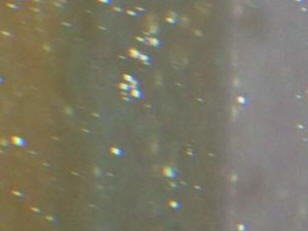 |
|
Brown Plant Growth 11/27/08 I have a 300 Gal
reef, established over one year, lightly stocked. (3) 400 Watt
10K MH, all parameters look good. This brown plant growth on the
rock comes and goes in cycles every two weeks or so. About 1/2
inch growth, with fine thin leafy tops. I brought a sample to the
LFS, they could not find any critter who would eat it. Thanks,
Steve <Hmm... I could be wrong, but these look like hydroids
to me. http://www.wetwebmedia.com/hyzoanidfaq.htm Best,
Sara M.>
|
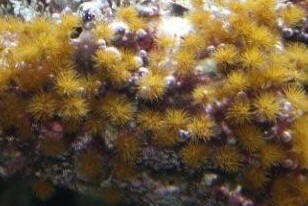 |
|
Deep Water Coral Identification
11/16/08 Hi There. I was wondering if you guys would
have any insight to what kind of coral this might be? I was
fishing off of the Florida Keys where I live. We were fishing a
large hump that comes up from 1300 ft. to about 600 ft.. On top
of this hump we snagged this big coral on our line, which we
thought was a fish at one point. when we got if to the surface It
was something I have never seen before. I work for a company down
here which supplies Caribbean life to zoo's and aquariums all
over the world, and it has stumped everyone. <I do think it
must be a hydrocoral of some kind. A close-up pic of the polyps
would make it easier to ID with more certainty. I would also be
careful not to be breaking the law here. If it's a protected
species, it might get you into trouble taking it home... but
I'm sure, with your job, you know about all that. :-)> Any
suggestions on whit it is and maybe the best way to try and keep
it alive? <If it is indeed a Hydrocoral from 600ft then it
likely doesn't need much, if any, light. It will need quality
feeding... they are not too difficult to care for if they were
healthy when you get them (which this one appears to be).
Best,
Sara M.>
|
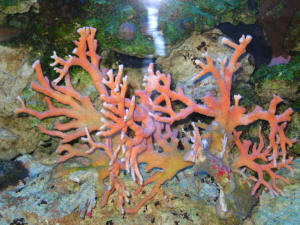 |
|
Hydroid, ID, control... 11/14/08
Hello all! <Mariusz> I was hoping you could give me an ID
(ie. scientific/common name) on this Hydroid. It was taken from:
http://www.wetwebmedia.com/hyzoanidfaq.htm (i have also attached
the same pic). I have a bunch of these in 120 tank with about
140lbs of live rock. <Mmmm... can't tell the species from
this small pic> I recently took all fish out of the tank to
let run fallow after a parasitic infest. Most corals have been
removed (for other reasons). All that is left are a few mushrooms
and leathers, peppermint shrimp, hermits. The tank has been
running fallow for 6 weeks now and I'm in no rush to put my
livestock back in. Also for 6 weeks I haven't put any food in
the tank either, it's just been running with Deltec skimmer
(which hasn't produced much as I have almost no livestock and
no feeding). So questions: 1) are these hydroids a danger to
fish? not sure how potent the sting is. <Could be... if
they're unaware, get too much exposure> 2) How can I rid
these with out manual removal as I've been trying for almost
a year. Not sure if these guys are worms of some sort and if
de-wormer will work, possibly Prazi or other. Is there any
biological alternative? Without proper ID its been difficult
moving forward towards a solution. Thanks <Can be very
difficult... frustrating up to the point, extreme, of making it
reasonable to bleach/kill all LR, start over with some new LR
material placed over, amongst, using the killed rock as base...
Otherwise, you might be lucky to discover a predator (perhaps an
Opistobranch...), but even here, they wouldn't eliminate
all... "So many chickens, so many foxes"... Bob Fenner,
who would bleach, nuke>
|

|
Re: hydroid 11/15/08
I've attached 2 pics of these hydroids (pulled out of
the aquarium and place them on paper). Is it possible to
identify them now? Are they some type of worm? <Mmm,
much more likely tube snails... though could be
Sedentariate Polychaete worms... You can tell if/when
they're "open" underwater> Will Prazi or
some type of anthelminthic work? Any suggestions besides
nuking my system? Thanks once more <Mmm, I'd ignore
them... not deleterious... you could likely get a
crustacean that would predate these... I would not use
chemical controls.
http://www.reefs.org/library/aquarium_net/0897/0897_8.html
Bob Fenner>
re: hydroid... snails
11/15/08 Thanks for the link. However, the link
describes a mucus string/web produced by these worms but
there is no mention of sting. I've had mushrooms die
and retract if they are touched by these strands.
<Surprising...> Would these strands have some type of
sting? <Not as far as I've ever run into> The
link describes animals larger than the pics I sent. Animals
in my system have diameters of 1mm or less. So I take it
they are not hydroids? <Not hydrozoans, Cnidarians...
are Mollusks, Gastropods. B>
re: hydroid 11/15/08
I'm in complete agreement with you after further
surfing...just have to figure out why the mushroom died and
why any softy kinda retracts when the mucus strands are
out. Perhaps its something else I haven't noticed.
I'll be keeping a close eye. Thanks for all the help!
<Certainly welcome! BobF>
|
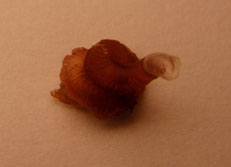 |
|
|
|

